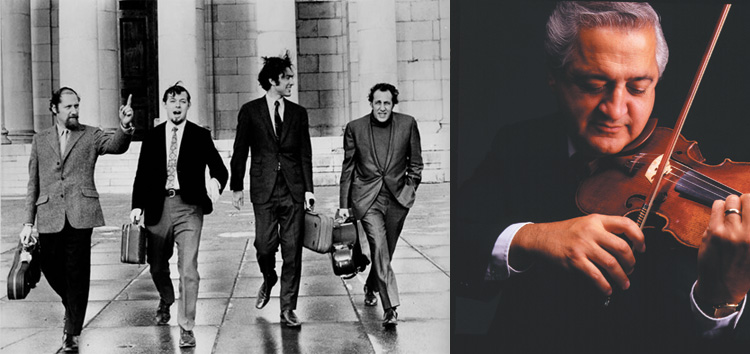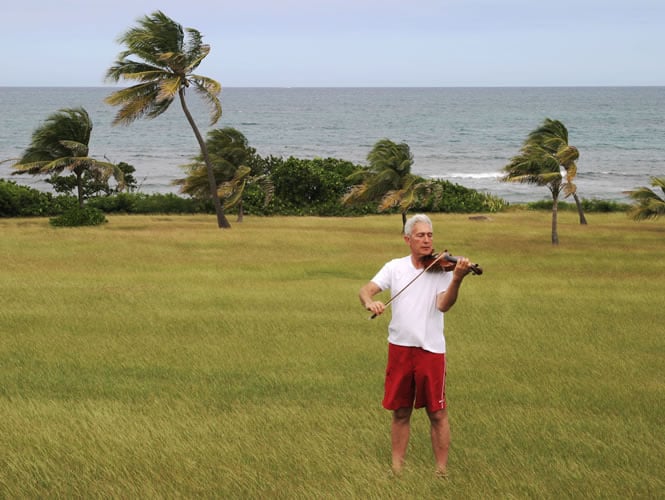.jpg) The Guarneri String Quartet (photo by Erwin Fischer) and Charles Avsharian
The Guarneri String Quartet (photo by Erwin Fischer) and Charles Avsharian
Arnold Steinhardt and I have shared decades of wonderful times beginning back in the ‘60s when we both participated in the Marlboro Festival. We had also been on a tour together where he was the featured young artist and I was in the small chamber group backing him. While we both studied under Ivan Galamian at the Curtis Institute and Meadowmount, it wasn’t until later that we actually met and formed a long-lasting friendship. Our mutual friends were many… all fun-loving young men and women from the finest musical backgrounds. What we all had in common was our passion for music… and having as many laughs as possible. Over the years, I’m happy to report, our strong link of a warm friendship has never waned.
We have kept up our happy valued relationship over the years… through the family times, the Guarneri times, my SHAR years, publishing the quartet’s Beethoven quartets (including some hours of amazing, unpublished videos made in his family apartment in NYC), dozens of concerts, and continuing up through current times. I can’t remember a time when a broad smile wouldn’t spread across my face after having lunch together or just hanging out for a while. Arnold is just that sort of person… he brings out what humor and joy you have that might be waiting for a tickle. His writing continues to tickle me… and I am absolutely certain that it will tickle you as well.
Charles Avsharian
CEO, SHAR Products Company
Editor's Note: The following story by Arnold Steinhardt originally appeared on his blog In the Key of Strawberry and is republished with permission. Steinhardt is the founding member of the Guarneri String Quartet and the author of two books: Violin Dreams and Indivisible by Four. For more stories visit here or follow on Twitter.
"Me and My Violin" by Arnold Steinhardt
Marc Lifschey, one of the greatest oboists of his era, once told me that after retiring as a performer and teacher, he had sold his oboe. On the face of it, giving up an instrument you no longer use seems perfectly reasonable, but nevertheless I was taken aback. Marc was not merely an excellent oboist; he was a great artist. His teacher, the French oboist Marcel Tabuteau, would often say to his students as a way of challenging them to lift music out of the ordinary: “You must mount your white steed and charge.” Marc could do that. The way he shaped a phrase in Bach’s Cantata #82, Ich Habe Genug, or in Schubert’s Great C Major Symphony always gave me goose bumps. Still, Marc didn’t do it alone. He and his oboe did it together. Even in retirement, wouldn’t Marc have some sort of lasting relationship with his oboe that transcended performing on it? Wouldn’t he want to keep it if for no other reason than as a reminder of the magnificent music the two of them had made together?
On the other hand, Efrem Zimbalist, the internationally renowned violinist, kept his instrument for a good thirty years after retiring from the concert stage, until his death at ninety-four. Despite marked hearing loss, he continued to practice daily until the very end of his life. One wonders why, with no concerts in mind and with the likelihood that he would play well below his high standards due to hearing impairment, Zimbalist continued to practice.
Joseph Roisman, the distinguished first violinist of the Budapest String Quartet, seemed to be content giving up his beloved Lorenzo Storioni when he agreed to sell it to me after the Quartet retired. But when I finally met with Roisman, he had second thoughts. “Steinhardt,” he said to me plaintively, “I’ll sell the violin to you some day, but for now I’m enjoying playing chamber music with my friends every Friday night.” And that is exactly what he did until his death a year or two later.
Lifschey, Zimbalist, and Roisman dealt with retirement in different ways, but their stories set me wondering not only about what I’ll do with my violin if and when I retire, but also about the very nature of a musician’s day-to-day, year-to-year relationship with his instrument.
I began playing the violin when I was six years old and now I’m seventy-six. The violin has been an integral part of my life for the last seventy years. Does that make the violin my very close friend? Well, yes. Sometimes. The violin obviously can’t speak with words, but when I ask something of it, the instrument can respond with an astonishing range of substance and emotion. This is friendship on a most exalted level. Sometimes.
There are those other moments, however, when the violin stubbornly refuses to do my bidding, when it only reluctantly plays in tune, or makes the sound I want, or delivers the music’s essence I strive for. Then I have to cajole, bargain, or adjust to its every whim. Some friend. More like an adversary, you might say.
Or is the violin my partner? A woman once went backstage to congratulate the great violinist Jascha Heifetz after a concert he’d just given. “What a wonderful sound your violin has, Mr. Heifetz”, she enthused. Heifetz leaned over to his violin that lay in its open case, listened intently for a moment, and said, “Funny, I don’t hear a thing.” My violin also lies mute in its case without me, but on the other hand I stand mute on the concert stage without it. Call this either a severe case of co-dependence or a heavenly partnership; the fact is that, inextricably entwined, we need each other.
If the violin is indeed my partner, it’s one that demands intimacy. When I hold the violin, my left arm stretches lovingly around its neck, my right hand draws the bow across the strings like a caress, and the violin itself is tucked under my chin, a place halfway between my brain and my beating heart. Instruments that are played at arm’s length—the piano, the bassoon, the tympani—have a certain reserve built into the relationship. Touch me, hold me if you must, but don’t get too close, they seem to say. To play the violin, however, I must stroke the strings and embrace a delicate body with ample curves and a scroll like a perfect hairdo fresh from the beauty salon. This is an instrument I would never want to call Oscar or Albert, but what about Lola or Renata? Or maybe Serafina?
Am I getting carried away with all this talk about my relationship with a wooden box with four strings and some horsehair attached to a stick? After all, on some level the violin and bow I use to make music are merely my work tools and really no different from a carpenter’s hammer and saw or a plumber’s wrench. But whom am I trying to kid. I know of no plumber with a two-hundred-year-old wrench made by hand in Cremona, Italy. If my violin, made by Lorenzo Storioni in Cremona around 1785, is in fact a work tool, then it is a tool possessing the miraculous ability to touch the heart with its sound and excite the eye with its beauty.
What will I do with the Storioni—call it friend, adversary, partner, or work tool—if and when I’ve drawn the bow across its strings for the very last time in public? Will I take my violin out of its case from time to time and admire its beautiful shape and lustrous varnish? Will I hold it in my hands and think of the wonderful life we’ve had together, of those special performances that stand out in my memory: the late Beethoven quartet we played together in Chicago, or that Mozart concerto in Boston? Will I actually choose to practice—merely out of habit or for my own secret pleasure? Or will I decide that there is no point in having a violin I no longer play and that it is time to pass the instrument on to someone else?
Honestly, I just don’t know.
 Arnold Steinhardt (photo by Dorothea von Haeften)
Arnold Steinhardt (photo by Dorothea von Haeften)


